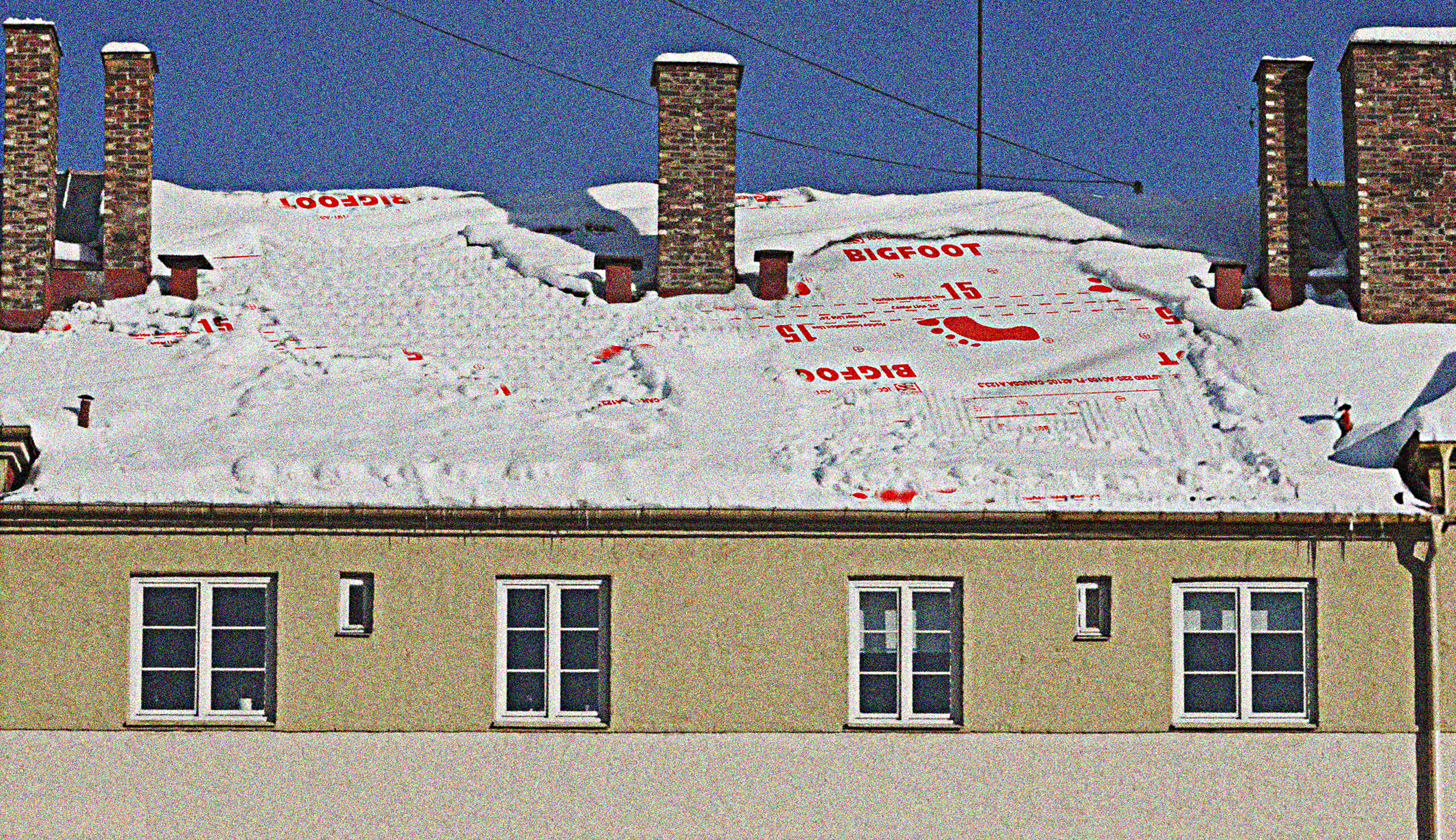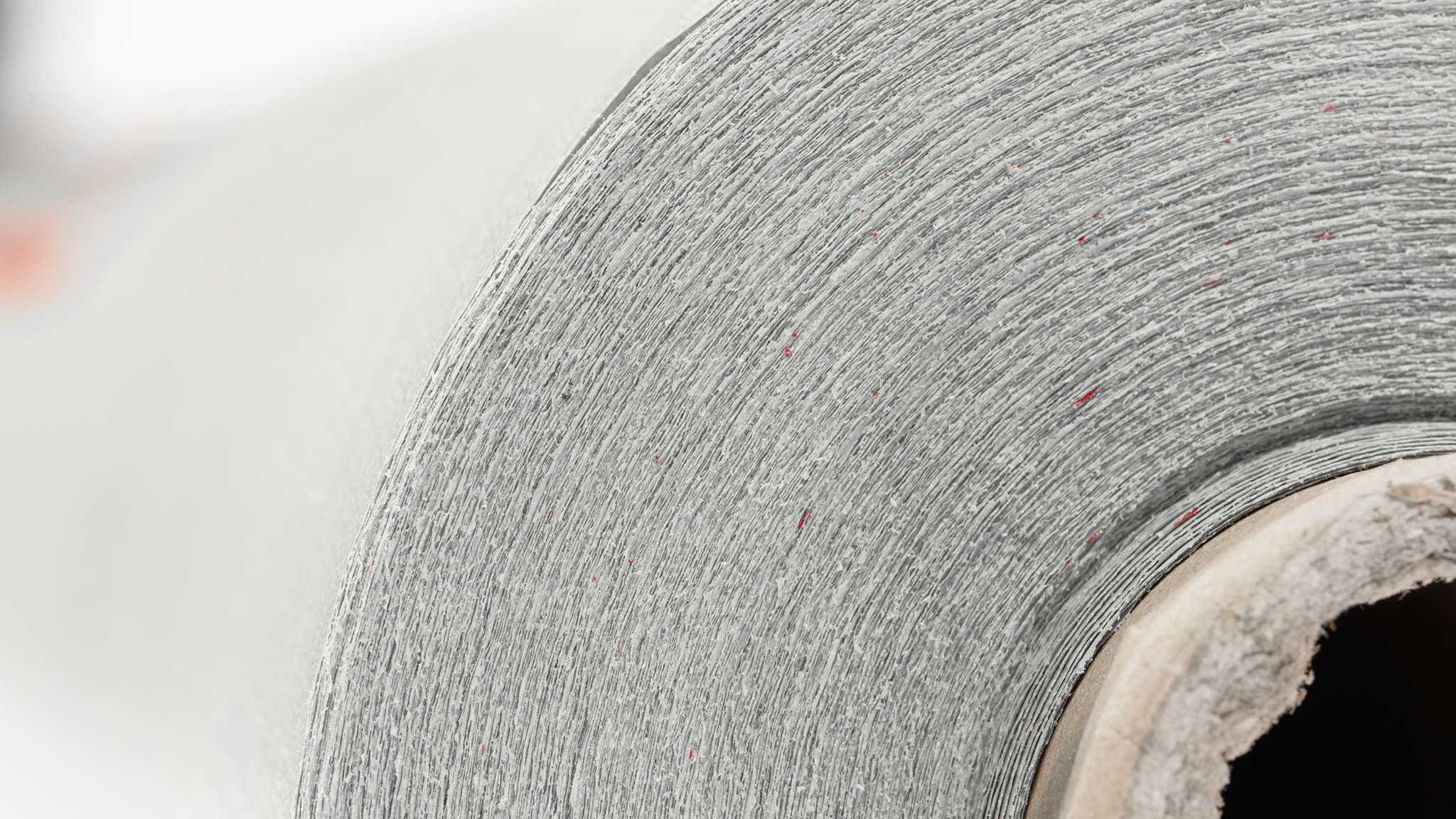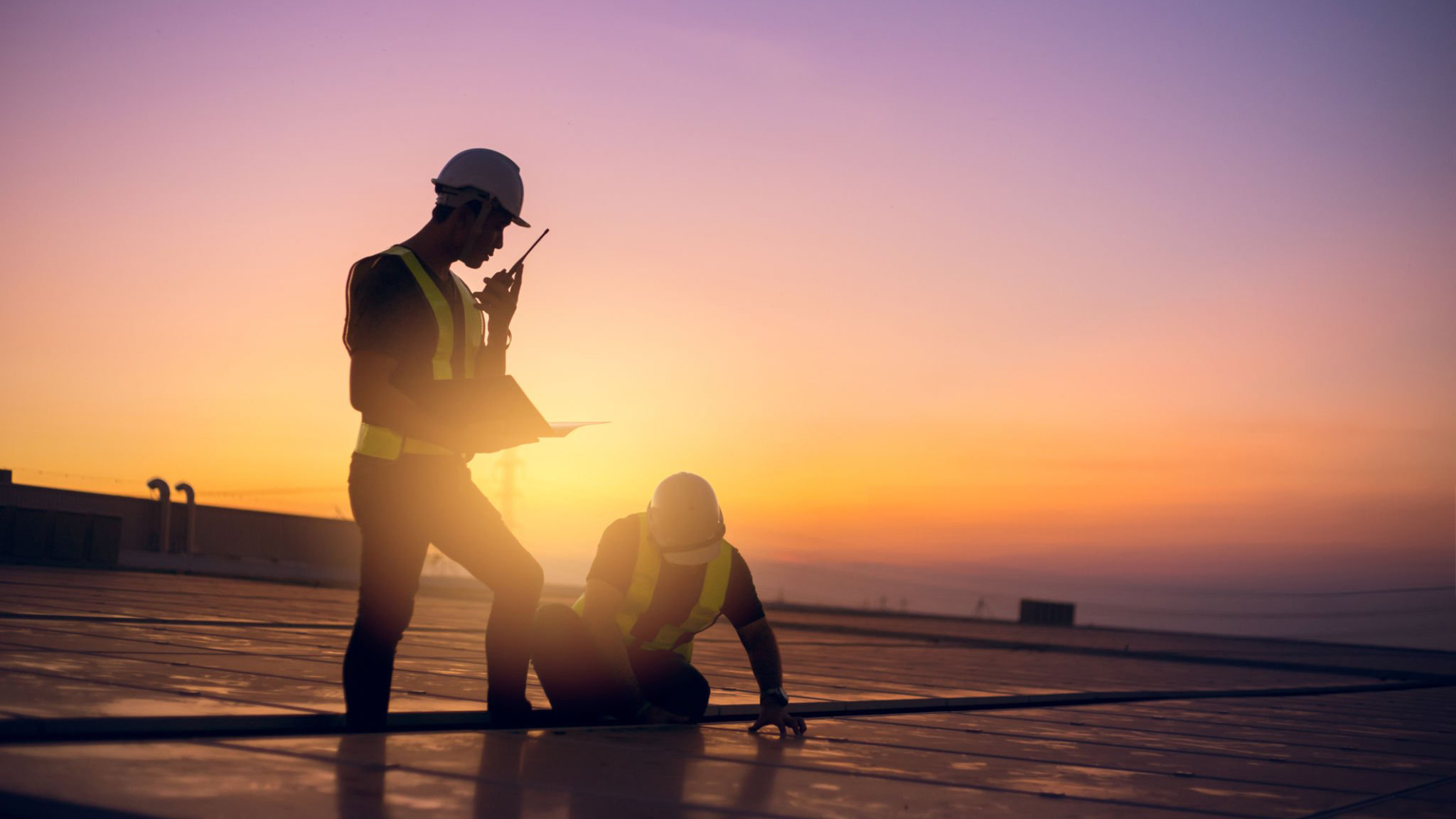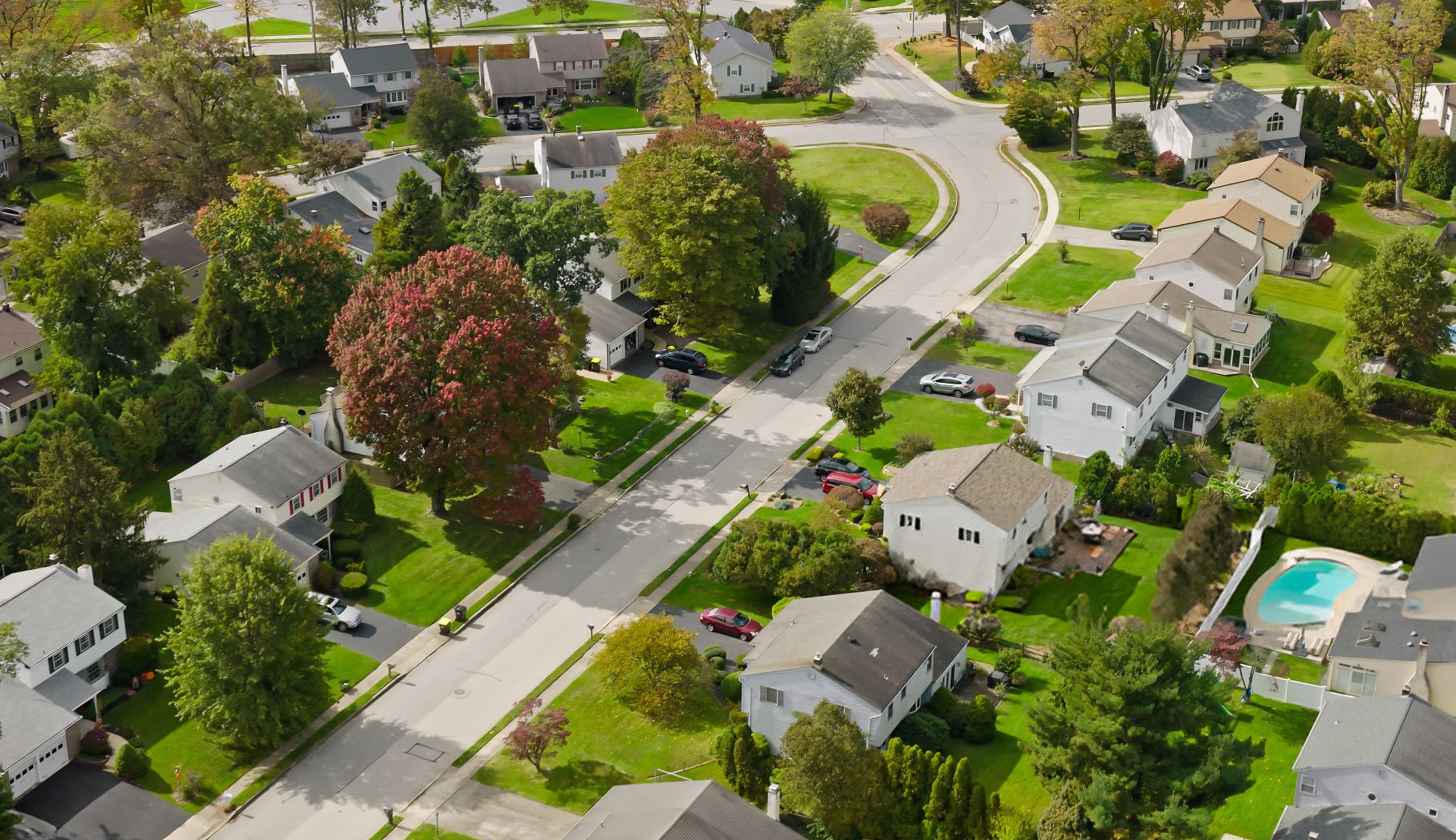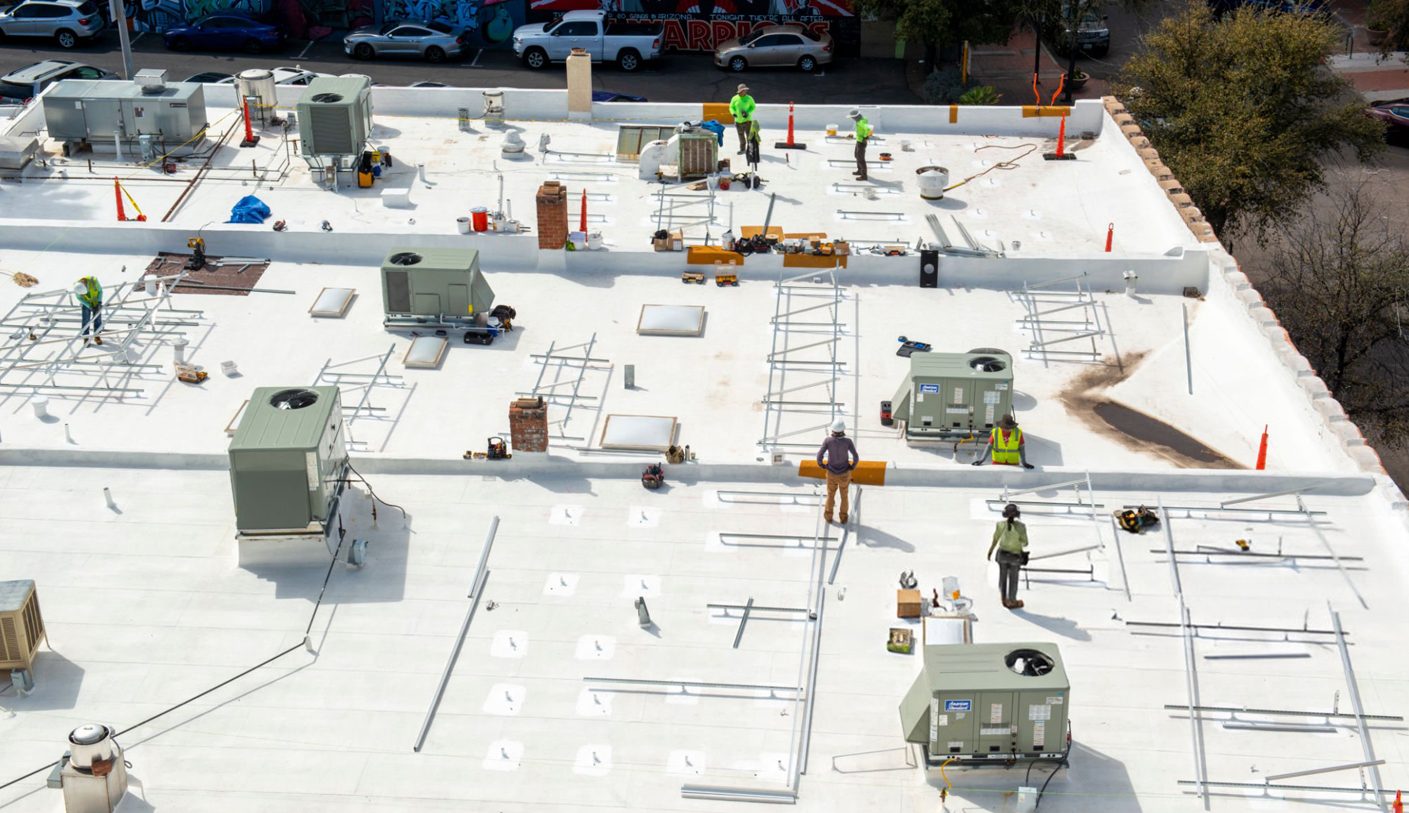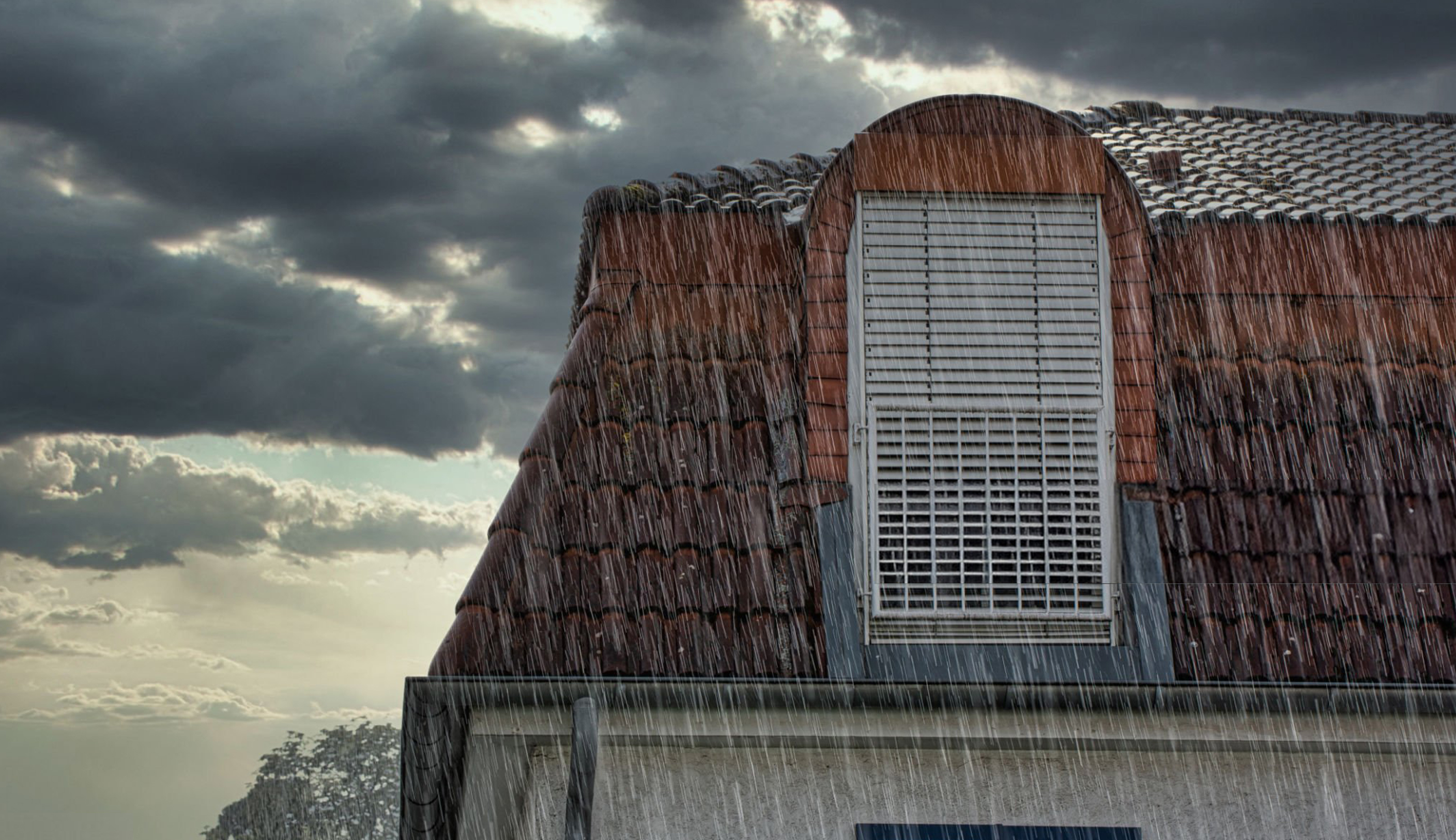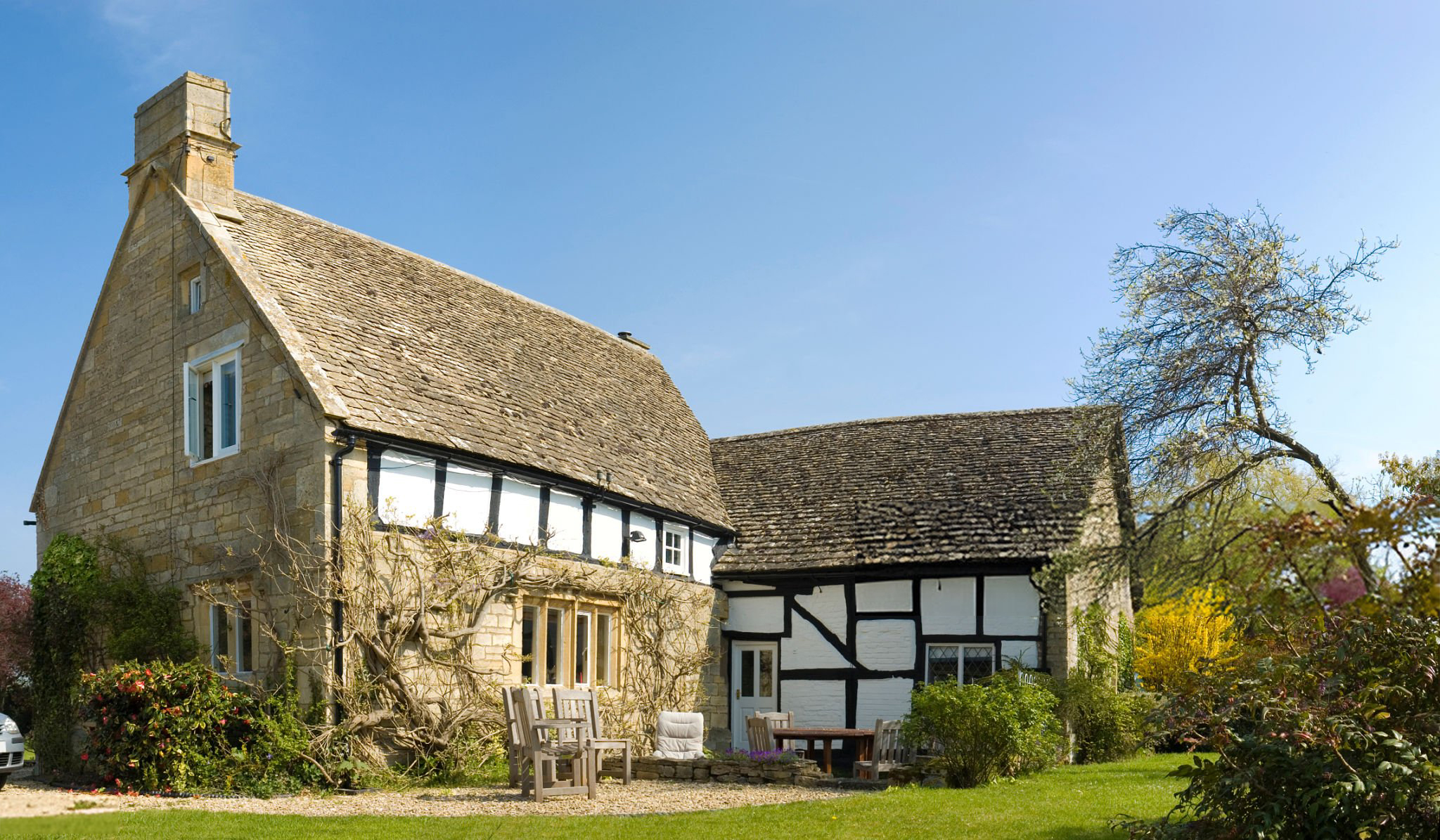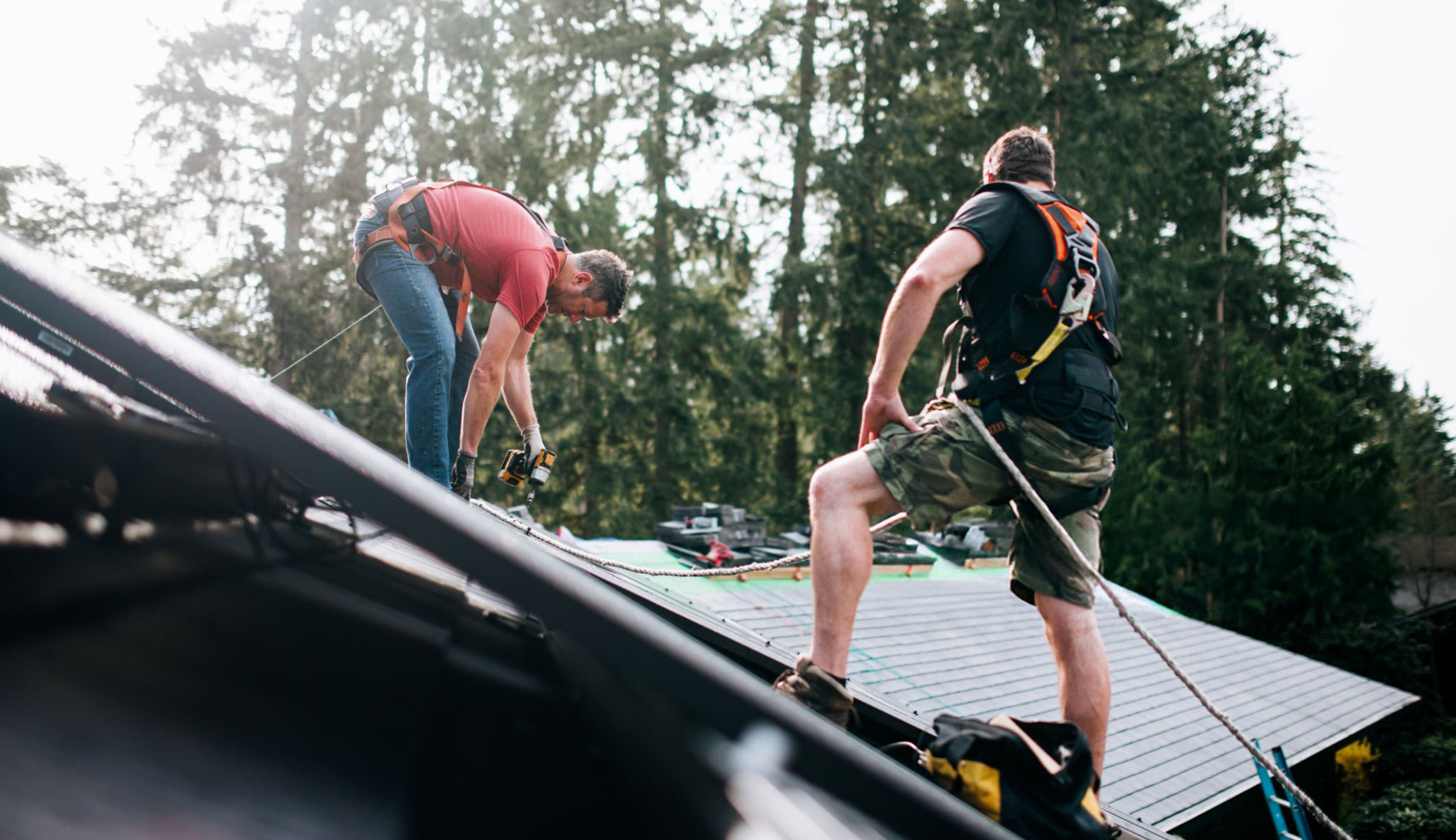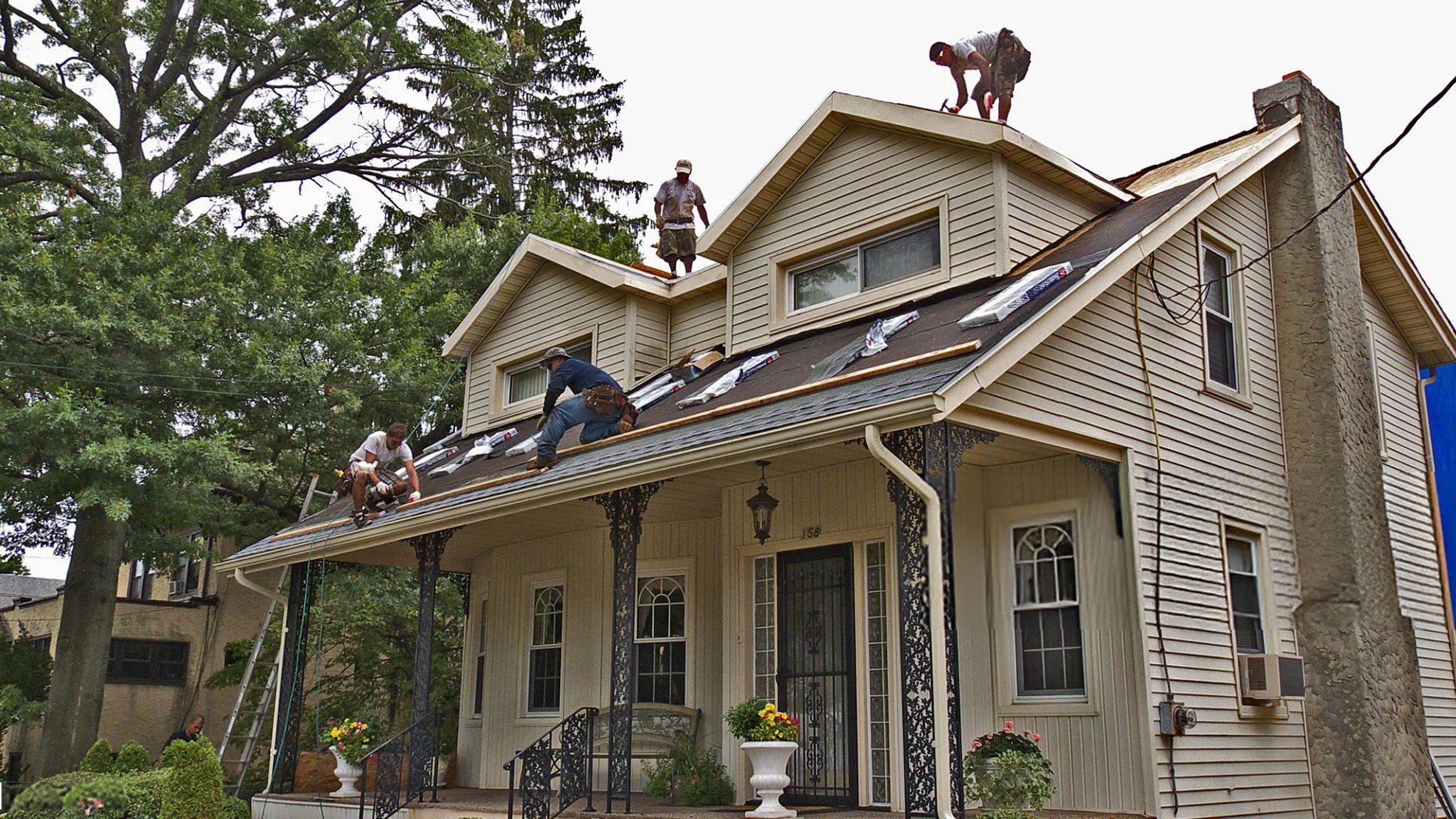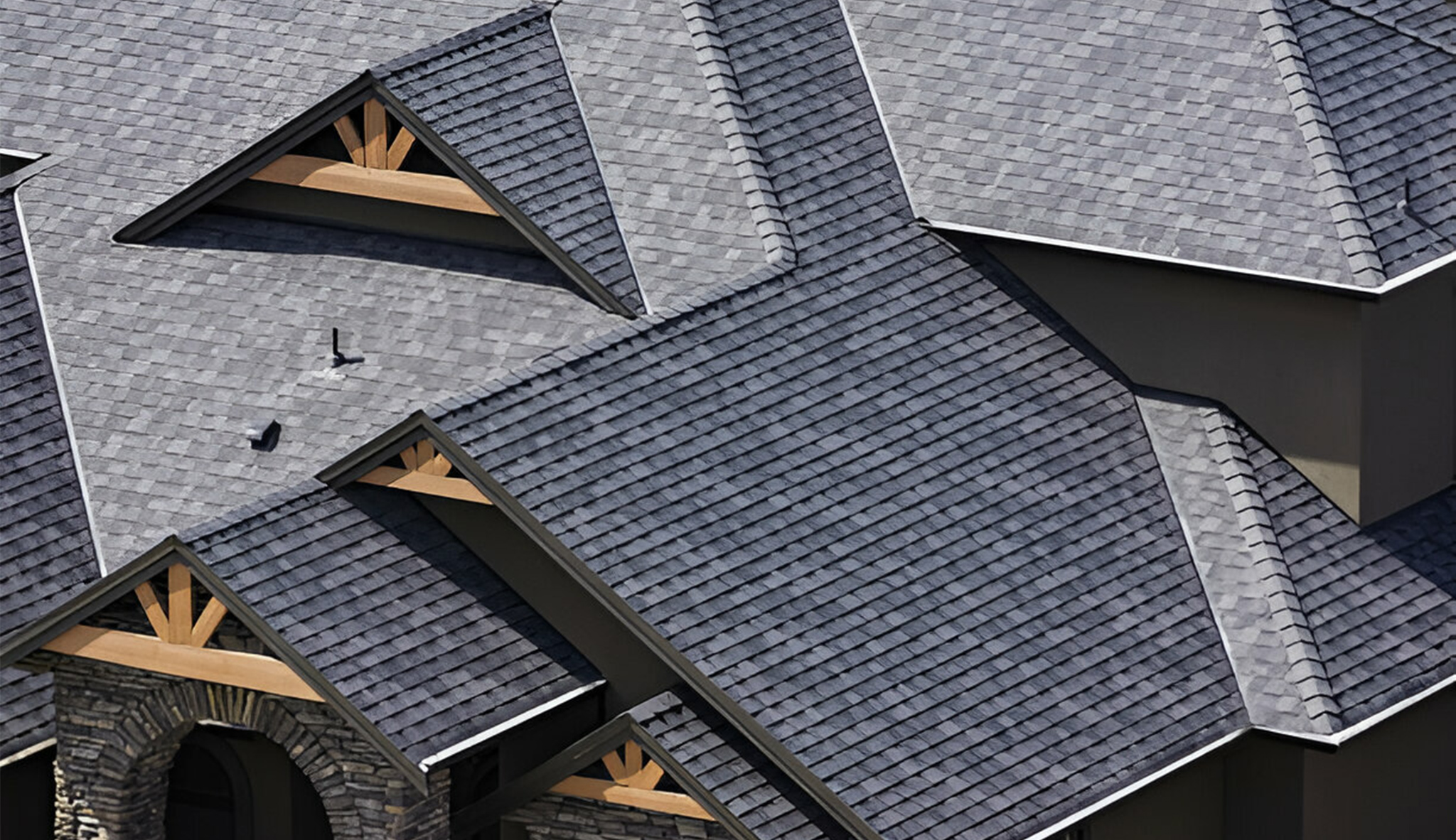Exploring Synthetic Roofing Underlayments: New Breakthroughs in Functional Materials
In the long journey of the continuous development of materials science, synthetic roofing underlayments, as an emerging and highly
promising material, are gradually coming into the public eye and have triggered extensive attention and application changes in
numerous roofing-related fields, becoming a hot topic within the industry.
The development of synthetic roofing underlayments can be traced back to the middle of the last century. At that time, with the vigorous
rise of the chemical industry and the gradual deepening of materials science research, researchers began to explore the use of synthetic
techniques to create roofing liner materials with better performance to meet the growing and diverse needs of the roofing industry.
The emergence of synthetic roofing underlayments was largely to make up for the many deficiencies of traditional roofing underlayments.
Traditional roofing underlayments have long been constrained by their own material properties and faced numerous thorny problems. For
example, under the influence of external environmental factors such as exposure to wind, sunlight, temperature changes, and humidity
fluctuations, traditional roofing underlayments are prone to material aging, becoming brittle, and losing elasticity, which in turn leads to
a significant reduction in their original functions like protection, cushioning, and isolation. Moreover, as the usage time increases,
traditional roofing underlayments often need to be replaced frequently, which undoubtedly brings higher cost burdens and a lot of
inconvenience to users.
In sharp contrast, synthetic roofing underlayments exhibit many remarkable advantages.
In terms of material stability, synthetic roofing underlayments have excellent weather resistance. Whether they are exposed to the
scorching sun for a long time, in a cold and low-temperature environment, or facing complex climatic conditions such as wet and
rainy weather, they can maintain the stability of their chemical structures and ensure that their performance is not greatly affected.
This is due to their advanced synthetic processes and carefully selected raw materials, which endow them with a natural ability to
resist environmental erosion and enable them to play a reliable role for a long time, greatly extending their service life.
In terms of physical properties, the strength performance of synthetic roofing underlayments is quite remarkable. They possess relatively
high tensile strength, which means that during the installation process, even when subjected to external forces such as pulling and
bending to a certain extent, they are not prone to tearing or damage. For construction workers, this greatly reduces the construction
difficulty and enables them to complete laying and other related work more efficiently. Meanwhile, in the subsequent use stage, it also
reduces the trouble of maintenance or replacement due to accidental damage, ensuring the continuity and stability of use.
Furthermore, the versatility of synthetic roofing underlayments makes their application scenarios extremely extensive. In the roofing field
of the construction industry, they can be used as waterproof underlayments for roofs, effectively blocking rainwater penetration with their
tight structures, and can also serve as heat-insulating and sound-insulating underlayments in roof structures to create a comfortable
indoor environment. In the transportation field, when applied to the roof parts of vehicles such as automobiles, trains, and airplanes, they
can play a certain role in protection and heat insulation. They can also be used as seat underlayments inside vehicles to provide
passengers with a pleasant riding experience through good elasticity and comfort. And during cargo transportation, they can be used as
cushioning underlayments on the roof to protect the goods from damage caused by vibration and collision. In the field of electronics
and electrical appliances, they can provide isolation and protection for some precision electronic components placed in the roofing
environment, preventing electrostatic, dust and other factors from damaging the components and ensuring the normal operation of
electrical equipment.
In addition, as the concept of environmental protection has been deeply rooted in people's hearts around the world, the research and
development and production of synthetic roofing underlayments have increasingly focused on green and sustainable development.
Many of the raw materials used in synthetic roofing underlayments are recyclable, and the production processes are constantly being
improved in the direction of low energy consumption and low pollution, minimizing the impact of this material on the environment
throughout its life cycle, which conforms to the current and future development trends.
It can be said that synthetic roofing underlayments, with their excellent performance, wide range of applications and environmental
protection characteristics, are gradually becoming a powerful substitute for traditional roofing underlayments, playing an increasingly
important role in numerous industries and injecting new vitality into the development of the materials field. There will surely be broader
application prospects waiting for people to further explore and discover in the future.
2025-01-20
DETAIL

Achieving Lightweight and Efficient Installation, Facilitating the Development of Multiple Sectors
In recent times, within a multitude of engineering construction and industrial application scenarios, a novel type of liner has been
instigating a revolutionary trend by dint of its attributes of lightweight and efficient installation. It has exerted significant positive
influences on various industries and has emerged as a focal topic that has garnered substantial attention within the industry.
Historically, in the realm of construction practices, the selection and installation of liner materials have invariably posed challenges for
numerous projects. Traditional liners were characteristically bulky and heavy. For instance, certain conventional rubber liners or fabric
composite liners demanded substantial manpower and material resources during the transportation phase. They frequently
necessitated the collaboration of multiple personnel or even the assistance of mechanical equipment for handling, thereby
undeniably augmenting the complexity of preparatory work and escalating the cost outlay. Moreover, the installation of these
hefty materials was fraught with difficulties. Specifically, in areas characterized by spatial constraints, at elevated heights, or
possessing irregular geometries, construction workers were compelled to expend copious amounts of time and energy on
adjusting positions and effectuating the laying process, consequently resulting in a rather low level of efficiency.
Nevertheless, this newly introduced type of liner has completely transformed this state of affairs. Consider, for instance, the
construction project of a large-scale modern warehousing center. It was imperative to install liners on the ground to guarantee
a moisture-proof environment for the storage of goods and to ensure the wear resistance of the ground surface. The construction
team opted for this new type of liner, whose weight was merely approximately one-third of that of traditional liners with comparabl
functions. Upon the delivery of the materials to the construction site, workers were able to effortlessly transport them to the
designated locations, and a single individual could manage the movement of liners covering small areas, thereby effecting a
significant reduction in labor costs.
During the installation procedure, the new type of liner exhibited unparalleled efficacy. Its material boasts excellent plasticity, enabling it
to be deftly cut in accordance with the actual shape and dimensions of the site, with edges that are both neat and capable of seamless
splicing. Construction workers are merely required to adhere to the design blueprint, simply laying and joining the individual pieces of
the new type of liner successively, and subsequently employing specialized sealants or connecting components to expeditiously complete
the installation work across a broad area. Initially, it was projected that the installation would span several days; however, in actuality, it
was accomplished within less than two days, thereby securing precious time for the overall construction progress of the warehousing
center.
It is worthy of note that the advantages proffered by the lightweight and efficient installation of this new type of liner have also permeated
into numerous other domains. In agricultural irrigation projects, the lightweight nature of this new type of liner renders it convenient for
laying within irrigation channels, thereby facilitating the prompt completion of anti-seepage work and curtailing the wastage of water
resources. In chemical production facilities, the new type of liner utilized for safeguarding the ground and equipment can be swiftly installed
in position, thereby erecting a robust safety protection framework for ensuring safe production.
With the continuous innovation and progression of technology, the performance of this new type of liner remains in a state of perpetual
optimization. The merit of lightweight and efficient installation is anticipated to shine brightly in a greater number of engineering projects
and industrial applications, persistently contributing to the impetus for the high-quality development of diverse industries. We are also
looking forward with anticipation to its creation of additional value and possibilities in the future.
2025-01-17
DETAIL

Riding the Wave of Development and Breaking Through Challenges: Dynamics and Prospects of Key Links in the Construction Field
Against the backdrop of the booming global construction industry, there is a field that, though not often in the spotlight, plays a vital role
in ensuring the stability, waterproofing, and overall performance of building roofs. It is currently in a process of continuous evolution and
development.
Market Development Trends: Expansion in Scale and Diversification of Demand
In recent years, the relevant market has shown a steady expansion trend. On the one hand, the continuous urbanization construction and
renovation projects of old buildings in various regions have continuously generated a demand for corresponding products. Whether it's
the numerous commercial buildings in bustling cities, various residential buildings in vast rural areas, or the numerous industrial factories
dotted around, all rely on the support of such products.
In regions where the construction industry is highly developed, people have extremely high requirements for the quality of residential and
commercial buildings, and correspondingly, their expectations for the performance of relevant products have also risen. Construction
projects in these areas often tend to choose high-end products that possess excellent durability and can cope with complex climatic
conditions to ensure that the building roofs remain intact during long-term use.
Product Pattern: Rich in Variety and Each with Its Own Advantages
Currently, the relevant products present a diversified and rich pattern. Various products, relying on their unique performance advantages,
are able to demonstrate their capabilities in different building application scenarios.
Certain traditional products have a profound historical background and mature production processes, with relatively low costs. This
enables them to still maintain a certain market share in numerous low- and medium-end construction projects with limited budgets.
Although compared to some new products, they may fall slightly short in high-end performance, for small residential buildings, simple
warehouses, and other buildings where the requirements for roof performance are not particularly stringent, they can provide basic and
reliable waterproof functions, undoubtedly making them an economical choice.
There is another type of product that is renowned for its outstanding weather resistance, chemical corrosion resistance, as well as
excellent elasticity and tensile resistance. Whether facing the scorching sun, torrential rain, or complex environments, it can demonstrate
strong tolerance to ensure the stability and safety of the roof structure. For this reason, large industrial factories, warehousing and logistics
centers, and commercial buildings with extremely high requirements for roof durability often choose this type of product as their first choice,
safeguarding the long-term use of the buildings.
Industry Transformation Trends: Environmental Protection and Intelligence Leading the Future
With the increasing emphasis on environmental protection, energy conservation and emission reduction, and building intelligence around
the world, this field is also being caught in a profound wave of transformation. Green environmental protection and intelligent functions
have become the two core trends in its development.
In terms of environmental protection, more and more enterprises are actively responding to the call for sustainable development and are
committed to researching and developing relevant products made from recyclable and renewable materials. For example, some enterprises
have begun to attempt to use new environmentally friendly materials to replace traditional raw materials. The products produced not only
possess the environmental protection characteristics of being degradable and renewable but also significantly reduce the impact on the
environment throughout their entire life cycle. Meanwhile, enterprises also focus on optimizing production processes and improving energy
utilization efficiency during the production process, fully implementing the environmental protection concept from the production source to
product use and finally to disposal, striving to make relevant products an important part of green buildings.
Challenges: Forging Ahead and Seeking Breakthroughs
The frequent fluctuations in the prices of raw materials have brought significant cost control challenges to enterprises. Since the
production of relevant products relies on multiple raw materials, and the prices of these raw materials are affected by many factors
such as global market supply and demand relationships and geopolitics, they often experience unstable fluctuations. This causes
enterprises to face many uncertainties when formulating product prices and planning production scales, and their profit margins
are often squeezed.
However, it is precisely these challenges that have driven enterprises in the industry to actively seek breakthroughs. They strengthen
in-depth cooperation with raw material suppliers, sign long-term and stable supply agreements, and jointly explore solutions for the
stability of raw material supply and cost optimization. At the same time, enterprises also enhance exchanges and cooperation, form
industry alliances or participate in industry association activities, jointly respond to the complex and changing policy environment, share
technological research and development achievements, and work together to promote the entire field to develop in a healthier and more
sustainable direction.
2025-01-16
DETAIL

Innovative Shield: Fortifying Building Defenses in Extreme Cold
With the continuous expansion of the global construction industry into cold regions, extreme cold environments pose numerous severe
challenges to building structures. As a crucial line of defense for buildings against the external environment, the protective performance
of roofs is severely tested under low - temperature conditions. Recently, a roof synthetic gasket specifically designed for extreme cold
environments has made a stunning debut, presenting a brand - new solution to this problem.
Extreme cold regions frequently experience harsh weather conditions such as low temperatures, heavy snowfall, and strong winds.
Traditional roof gasket materials exhibit significant disadvantages in such environments. Low temperatures can cause the materials to
shrink and become brittle, leading to cracks in the roof, severely compromising its sealing and waterproofing properties. The heavy
pressure of snowstorms can easily damage vulnerable gaskets. Once the gasket fails, the interior of the building will face issues such
as water leakage and reduced insulation performance. This not only affects the living comfort but may also cause long - term damage
to the building structure.
Through innovative material formulations and advanced manufacturing processes, relevant synthetic gaskets have successfully overcome
these difficulties. In extremely cold temperatures, they can always maintain good flexibility and ductility. Even when repeatedly compressed
by heavy snow, they can quickly return to their original state, always closely adhering to the roof structure, ensuring excellent waterproofing,
windproofing, and insulation effects.
Judging from extensive practical application feedback, numerous buildings in extremely cold regions that have adopted this synthetic
gasket have demonstrated excellent protective performance when facing extreme weather. Compared with surrounding buildings using
traditional gaskets, these buildings effectively avoid common problems such as roof water leakage and insulation layer damage. The
indoor temperature can be stably maintained, greatly enhancing the safety and comfort of living and using the building.
With the continuous deepening of global development in cold regions and the increasing demand for building safety and comfort in
extreme environments, the application prospects of this synthetic gasket are extremely broad. Whether it is for civil residential buildings,
commercial buildings, or industrial facilities, it will become a solid shield for buildings in extreme cold environments, strongly promoting
the sustainable development of the construction industry in cold regions and creating a safer and more comfortable living and working
space for people in frigid zones.
2025-01-15
DETAIL

Ushering in a New Era of Low - Cost and High - Value Roofs
In the field of roofing materials in the construction industry, a quiet revolution is taking place. As a powerful alternative to traditional
asphalt felt, roof synthetic underlayment is rewriting the rules of cost - effectiveness and value enhancement for roofs with its superior
performance.
Although the price of synthetic roof underlayment is slightly higher than that of traditional asphalt felt during initial procurement and
installation, its huge advantages throughout the entire roof life cycle make it a highly cost - effective choice in the eyes of many building
owners and developers.
Reducing Repair and Maintenance Costs: Creating a "Zero - Burden" Roof
The excellent waterproof performance of synthetic roof underlayment is the key to reducing maintenance costs. Its tight material structure
effectively reduces leakage points and greatly reduces the risk of leakage. According to industry data, the repair frequency caused by roof
leakage in buildings using synthetic roof underlayment is approximately 70% lower than that in buildings using asphalt felt. This means a
significant reduction in labor costs and the material costs required for repairs. Moreover, due to the reduction in leakage, the interior
decoration, insulation layer, and structural components below the roof are better protected, avoiding damage caused by water
penetration and further saving potentially high repair costs. Many commercial buildings that have adopted synthetic roof
underlayment have hardly required large - scale roof repairs in the ten years since they were put into use, achieving an almost
"zero - maintenance" ideal state.
Strong Durability: Extending the Service Life of the Roof
Synthetic roof underlayment performs remarkably in withstanding harsh environments. It can effectively resist the erosion of ultraviolet
rays and will not age rapidly due to long - term sun exposure like traditional asphalt felt. At the same time, it also has good adaptability
to drastic temperature changes and will not crack due to thermal expansion and contraction. In extreme weather conditions such as strong
winds and heavy rains, its tough material can remain stable and is not easily torn. This excellent durability significantly extends the service
life of the roof. Taking residential buildings as an example, the service life of roofs using synthetic roof underlayment can reach 25 years or
even longer. In contrast, traditional asphalt felt roofs usually only last for 10 - 15 years, thus saving property owners huge expenses for
multiple roof replacements in the long run.
Increasing Property Value and Living Comfort: Dual Benefits
From the perspective of the real estate market, properties with synthetic roof underlayment have higher value. When homebuyers are
choosing houses, a high - quality roof system is an important consideration. The high quality and low maintenance costs represented by
synthetic roof underlayment make houses more attractive in the market and enable them to obtain a higher selling price. A survey of
second - hand housing transactions found that houses with synthetic roof underlayment have a selling price approximately 5% - 8%
higher than those of the same type in the same area but with traditional asphalt felt roofs.
For residents, synthetic roof underlayment brings a more comfortable living experience. Its good heat insulation performance ensures
that the indoor temperature is not too high in summer and not too low in winter, reducing the frequency of using air conditioners and
heating equipment. This not only saves energy costs but also creates a pleasant living environment for residents throughout the year.
In addition, due to its excellent waterproof performance, it eliminates problems such as indoor dampness and mildew caused by roof
leakage, ensuring the health of residents.
With the continuous advancement of construction technology, roof synthetic underlayment, with its unparalleled advantages, is
bringing new concepts of cost - effectiveness and value enhancement to the construction industry. In the future, it is expected to
become the mainstream choice for roofing materials, leading the construction industry towards a more efficient, environmentally
friendly, and economic new era.
2025-01-14
DETAIL

Roof Innovation: Multi-compatible Materials Usher in a New Chapter in Architecture
In the surging wave of the current booming construction industry, the roofing engineering field has witnessed a remarkable breakthrough.
An innovative achievement has made a dazzling debut, seemingly finding an accurate solution to the compatibility problems of various
roofing materials, injecting new vitality into building roofing projects and opening a chapter of transformation.
Looking back, traditional roof waterproofing construction was fraught with difficulties. Roofing materials of different materials have vastly
different physical and chemical properties, resulting in extremely high requirements for compatible auxiliary materials. Consequently, the
construction process was complex and lengthy, like groping in a maze. This not only consumed a large amount of manpower, material
resources and time, but also led to uneven waterproofing effects, laying many hidden dangers for the overall quality and lifespan of
buildings.
However, difficulties inspired innovation. Relying on profound professional knowledge and unremitting exploration spirit, the scientific
research team conducted repeated research and experiments and finally developed a breakthrough technology. Once this technology
came out, it caused a stir in the construction industry.
Take the common asphalt shingle roof as an example. As a thermoplastic material, it is extremely sensitive to environmental temperature
changes. Seasonal alternations and day-night temperature differences can cause it to undergo obvious expansion and contraction
deformations. Nowadays, the newly developed compatible material is like a professional and tacit partner, closely adhering to the
underside of the tile base. With excellent flexibility and precise elastic modulus compatibility, it perfectly conforms to the "rhythm" of
the thermal expansion and contraction of the asphalt shingles, and seals potential gaps and pores one by one with outstanding sealing
performance, building a solid waterproof barrier for the roof, keeping the indoor space away from wind and rain, and creating a peaceful
and comfortable environment for the occupants.
When it comes to metal roofs, the innovation advantages are even more prominent. Metal materials conduct heat rapidly. In the outdoor
environment, temperature gradient changes and atmospheric corrosive media often cause them to experience thermal expansion and
contraction deformations, oxidation and rust, as well as friction damage with the base structure. The new compatible material steps
forward with stable chemical inertness and excellent buffer damping characteristics, intervening between the metal plate and the base
to effectively block external erosion, reduce heat stress conduction, and buffer friction collisions caused by displacement. Even when
strong winds, heavy rains and extreme weather strike, relying on its super adhesion and peel resistance properties, it can be firmly
connected to the metal plate to stabilize the roof structure and act as a solid backstop.
Especially in the era of diversified development of building materials, synthetic underlays have emerged in large numbers and become a
new force in roof protection. The new compatible material precisely meets its needs and shines brightly in its combination with synthetic
underlays. With unique compatibility design and optimized fitting performance, it skillfully balances the maximization of the protection
function of the synthetic underlay and its own reliable support requirements. Without affecting the normal protection process of the
synthetic underlay, it comprehensively helps it resist wind and rain, dust and sand. With super weather resistance and anti-aging
properties, it withstands long-term ultraviolet radiation, damp heat alternation and low-temperature freeze-thaw cycles, sticks to its
post, cooperates with the synthetic underlay, and escorts the long-term stable operation of the roof system, strongly promoting the
construction of high-quality roofs.
At present, this innovative achievement has successfully passed strict international and domestic quality standard tests and performed
brilliantly in several representative pilot projects. In the construction stage, professional teams highly praise its simple and efficient
installation process, which significantly shortens the construction period, reduces the difficulty of manpower allocation and minimizes
human error risks. Its waterproof sealing effect far exceeds that of traditional products, greatly reducing subsequent operation and
maintenance pressure and costs. On the end-user side, homeowners speak highly of the quality of the new roof. It has an elegant
appearance that conforms to modern aesthetics, and its durable characteristics further ensure the long-term comfort and safety
improvement of the home.
A series of remarkable achievements have attracted the attention of numerous construction enterprises, prompting them to decisively
incorporate it into their future project strategic blueprints, eager to put it into actual projects to seize the opportunity. With the market
demand growing exponentially like a snowball, the pace of its large-scale promotion and application is also accelerating.
Looking ahead, this achievement, which bears infinite innovation potential and development prospects, will surely become a leading flag
for building roofs to move towards higher quality and stronger performance, helping to create batches of architectural models that
combine aesthetic design, practical functions, stable structures and durability, taking root in the forefront of building roofing engineering
and leading the industry towards a greener, smarter and more efficient future.
2025-01-13
DETAIL

Safeguarding the Roof Defense Line: The Stability of Synthetic Liners Becomes the Key
In the current booming construction industry, the roof, as the crucial defense line to protect buildings from wind and rain, demands
stricter quality control. And the roof synthetic liner, as the "unsung hero" in this defense line, its thermal stability and dimensional
stability are becoming the focus of the industry and triggering extensive discussions.
In the current booming construction industry, the roof, as the crucial defense line to protect buildings from wind and rain, demands
stricter quality control. And the roof synthetic liner, as the "unsung hero" in this defense line, its thermal stability and dimensional
stability are becoming the focus of the industry and triggering extensive discussions.
Recently, the results of a research on building materials are alarming. Many old buildings have problems such as roof leakage and
insulation failure. Tracing back to the source, it is mostly related to the poor stability of the roof synthetic liner. Under the scorching
sun in summer, some traditional liner materials, due to insufficient thermal stability, show signs of softening and flowing, resulting in
the rupture of the waterproof layer and allowing rainwater to seep in. In the cold winter months, the low temperature makes some
liners fragile and brittle. With slight external forces, such as snow accumulation and strong wind pulling, the liners crack, causing a
large amount of indoor warmth to be lost.
Thermal stability, simply put, is the ability of the liner to maintain its own performance in a high-low temperature alternating environment.
When the temperature soars, high-quality synthetic liners, relying on their special molecular structures and heat-resistant additives, can
hold their ground without deformation or aging, ensuring the integrity of the waterproof coating and the stability of the insulating air
layer. Conversely, if the thermal stability fails to meet the standard, the roof may instantly turn into a "steaming oven", with the scalding
hot air directly hitting the interior, making residents miserable; or when it rains heavily, the house may quickly become a "water curtain
cave", causing property damage.
Dimensional stability is equally important. Buildings will experience settlement, expansion, and contraction due to the passage of time
and climate change, and the roof is no exception. At this time, a dimensionally stable liner is like a flexible and loyal guard, closely
adhering to the roof surface, expanding and contracting with it, and seamlessly adapting to every subtle change. In contrast, for those
liners with poor dimensional stability, when there is the slightest movement on the roof, they will stretch and retract on their own, and
the seams will "open wide", allowing rainwater to rush in, eroding the building structure and greatly shortening the lifespan of the house.
Fortunately, researchers and enterprises have made significant progress in improving the stability of roof synthetic liners. From the
perspective of material innovation, new high-molecular composite materials have emerged. They are formed by combining multiple
high-temperature-resistant and tensile-resistant monomer components through complex processes, and their thermal stability and
dimensional stability far exceed those of traditional products. In terms of production technology, precise temperature-controlled
injection molding and multi-layer co-extrusion compounding technologies make the internal structure of the liner compact and orderly,
greatly enhancing the overall stability.
Nowadays, more and more builders put the stability of liners first when selecting materials and require suppliers to provide long-term
test data under simulated extreme environments to ensure everything is foolproof.
Looking ahead, although there are still challenges on the way forward, such as reducing the cost of high-performance liners and
accelerating the research and development of environmentally friendly products, with the continuous upgrading of technology,
roof synthetic liners will surely provide a solid "protective umbrella" for each building with more excellent thermal stability and
dimensional stability, safeguarding the warm lives of thousands of households.
2025-01-11
DETAIL

Guide to Roof Inspection for Second-hand Houses: Synthetic Underlayment Becomes a Wise Choice
In the current active real estate trading market environment, many homebuyers have set their sights on second-hand
housing resources. However, an easily overlooked yet crucial question arises: after buying a second-hand house, should
the roof be inspected? The answer is unquestionable — it must be inspected!
Many homebuyers take chances and are reluctant to bear additional maintenance costs too early. But once they move
in, the real challenges come one after another. The length of time the previous owner lived in the second-hand house is
unknown, and it's even more impossible to know when the roof was last repaired. A roof that hasn't been properly
maintained for a long time is like a "time bomb" that could trigger a series of problems at any time.
“The gaps in the old roof cause losses indoors during the rainy season"
Whenever the rainy season arrives, it's time for the old roof to "reveal its true colors". Rainwater seems to find a shortcut
to invade the house, seeping in through the gaps in the roof. Precious calligraphy and paintings, as well as knowledge-
bearing books, quickly become moldy and deteriorate under the attack of moisture, losing their original value; wooden
floors can't bear the weight of accumulated water and gradually deform and warp, not only affecting the appearance but
also posing a potential safety hazard; electronic devices short-circuit and get damaged in the "close encounter" with rainwater,
incurring high repair costs. Once these household properties are damaged, the economic losses are immeasurable, and
family life is thrown into chaos.
“From high initial purchase cost to long-term super returns”
Facing this dilemma, how can we find a permanent solution for the roofs of second-hand houses? Bigfoot synthetic
underlayment stands out and becomes the best choice. Although its cost is slightly higher than that of traditional
asphalt felt in the initial procurement stage, its advantages are obvious when looking at the long-term usage benefits.
The synthetic roof underlayment, with its outstanding durability, can withstand the test of time and stand firm year
after year; it greatly reduces the trouble of frequent maintenance, allowing homeowners to bid farewell to the troubles
of periodic roof inspections; most importantly, it minimizes the risks of leakage and damage. This means that in the
long run, homeowners can not only save on the high costs caused by repeated roof repairs but also avoid compensation
for property damage inside the house due to water infiltration, truly saving a large amount of money and safeguarding
family assets.
Nowadays, more and more second-hand homeowners have realized the importance of roof inspection and upgrading,
and they have chosen Bigfoot synthetic underlayment one after another to start a new chapter of worry-free home life.
Experts suggest that after the completion of a second-hand house transaction, homeowners should never neglect the
condition of the roof and should promptly choose high-quality synthetic underlayment to build a solid defense line for
their homes so that they can enjoy a comfortable living experience.
2025-01-11
DETAIL

Hidden Strength, Guarding High-altitude Safety
In the current period of continuous innovation in the construction sector, a quietly emerging material is silently rewriting the chapter of
roof construction and maintenance. It is the roof synthetic liner. Although not widely known to the public, its outstanding features,
especially its remarkable anti-slip property, have already become the unsung hero safeguarding high-altitude operation safety.
With the growing diversity of modern architectural styles, a large number of steep-slope roofs and special-shaped roofs that pursue
unique visual effects have emerged. While these undoubtedly add distinctive charm to the city skyline, they bring numerous potential
risks to construction workers who are busy moving about on the roofs and those responsible for subsequent maintenance. Traditional
roof liner materials generally have a smooth surface. Once wetted by rain, dew, or covered with a thin layer of dust, their surfaces
become slippery and the frictional force drops drastically. Just imagine, when workers are working on a high-altitude roof, it feels as if
they are standing on a perilous “skating rink”. Any slight misstep can easily lead to slips and injuries. If they are at a higher floor or in a
complex roof structure area, a chain reaction triggered by a single slip is likely to result in a serious fall accident, posing a great threat to
their lives.
Just when this thorny issue urgently needed to be resolved, the roof synthetic liner emerged like a ray of dawn breaking through the night
sky. It embodies the wisdom of cutting-edge material technology and has maximized the anti-slip performance. Its surface features not
ordinary textures, but fine and interlaced micro-protrusions and grooves meticulously designed and optimized by researchers, much like
the natural anti-slip “secret paths” crafted by nature. In a clear sky and dry, pleasant environment, these textures seem to come alive, like
countless invisible hands firmly gripping the soles of shoes, providing solid support for each step of the workers, enabling them to walk
on the roof as easily and confidently as on flat ground. Even when the weather changes abruptly and it rains heavily, causing water to pool
on the roof, the synthetic liner remains unfazed. The rainwater will swiftly drain away along the carefully designed grooves between the
textures, cleverly preventing the formation of large, bothersome water films on the surface. And those protrusions stand firm above the
water surface like pillars, always staying in close contact with the soles of shoes, ensuring that the friction between the soles and the liner
is not easily diminished by the rain. Even during daily operations when dust accumulates gradually, those fine dust particles, facing the
“maze” of grooved textures, can only look on helplessly, unable to fill them up, and the good frictional effect between the soles and the
liner persists. Whether workers are climbing a nearly vertical steep roof, leaning forward and concentrating, or in a critical moment when
the wind is howling and their center of gravity is unstable, relying on the powerful anti-slip guarantee of the roof synthetic liner, they can
stand firm, greatly enhancing the safety factor of high-altitude operations and adding a sense of security to every rooftop adventure.
Not only does it possess excellent anti-slip capabilities, but the roof synthetic liner also performs exceptionally well in terms of durability.
After long-term exposure to the merciless bombardment of ultraviolet rays, it will not, like ordinary materials, suffer from texture wear and
surface degradation that would lead to a significant reduction in anti-slip function. Behind this is the silent contribution of its stable and
elaborate high-molecular structure, which is like an impregnable fortress built for the surface textures, firmly locking every tiny protrusion
and groove. The ultraviolet rays in sunlight, like sharp “light swords”, can easily sever the chemical bonds of many conventional materials
and cause their molecular structures to collapse. However, the roof synthetic liner, by virtue of its unique molecular arrangement “shield”,
skillfully resists the invasion of ultraviolet rays, ensuring that the surface textures remain intact for years or even decades, always paving a
reliable anti-slip path for everyone who steps on the roof.
From the perspective of installation convenience, the roof synthetic liner offers even more advantages. It is as light as a gossamer, yet
harbors tenacious strength and has excellent flexibility. It can, like a nimble dancer, effortlessly conform to various complex and strange
roof contours. Construction workers only need simple tools to complete the laying work quickly and accurately, substantially shortening
the construction period and reducing the input of manpower and material resources. This is undoubtedly a timely boon for the
time-sensitive construction process.
In today’s era when the concept of environmental protection has deeply penetrated people’s minds, many roof synthetic liner products
closely follow the trend of the times and are carefully manufactured using recyclable environmental protection materials, minimizing the
negative impact on the ecological environment and perfectly aligning with the booming trend of green building.
Currently, although the roof synthetic liner is still in the ascending stage of market promotion, it has already made a mark in some newly
built high-end residential communities, extremely innovative commercial complexes, and large-scale industrial plants such as Oriental
Yuhong. It has won unanimous acclaim from architects, construction teams, and owners. Looking ahead, with the continuous improvement
of manufacturing technology and the steady control of production costs, it is expected that in the next few years, the roof synthetic liner will,
by virtue of its outstanding anti-slip performance, excellent durability, and convenient construction characteristics, spread like wildfire in
various construction projects, reshaping the safety paradigm of roof construction and maintenance and creating a more secure and
comfortable environment for people.
Admittedly, just as the growth path of all new things is frailed with thorns, the development of the roof synthetic liner also faces hurdles.
On the one hand, the market has a shallow understanding of its outstanding anti-slip advantages, and many potential customers, shackled
by traditional thinking, still tend to choose familiar traditional liners. On the other hand, the high initial R & D investment has led to a
relatively high initial price of the product, which, to some extent, restricts its market expansion pace. However, industry insiders generally
have an optimistic view of its development prospects. They believe that with the in-depth implementation of publicity and promotion and
the cost optimization brought about by large-scale production, these temporary obstacles will eventually be overcome.
In conclusion, the roof synthetic liner, by virtue of its outstanding anti-slip performance, excellent durability, convenient construction
advantages, environmental protection production concept, and broad development prospects, has already become a pillar in the field
of building safety and is expected to shine brightly in the near future, opening a new chapter in roof safety protection.
2025-01-10
DETAIL

Roofing Materials Innovation: Propelling the Construction Industry Towards a New Journey
In today's era of rapid development, the construction industry is undergoing a profound transformation spurred by innovations in roofing
materials.
Recently, a series of new roofing materials have emerged in quick succession, becoming the focus of attention in the industry. These
innovative achievements have first brought remarkable benefits in terms of energy utilization and cost control. There is a new type of
heat-insulating roofing material. Its breakthrough heat-insulation design makes buildings seem to be guarded by an efficient
heat-insulating barrier in summer. According to actual monitoring data, the indoor temperature of ordinary residences equipped with
this type of material is, on average, 5 to 8 degrees Celsius lower than that of residences using traditional roofing materials. This directly
leads to a significant reduction in the usage time of air conditioners and a sharp decrease in residents' electricity bills. For large buildings
such as commercial complexes and office buildings, the energy-saving effect is even more astonishing. It not only alleviates the urban
power shortage but also enables operators to save up to 30% of their energy consumption costs, greatly enhancing the overall
profitability of the projects and attracting the attention of developers and property owners.
In terms of enhancing building quality, innovative roofing materials also play a crucial role. The new waterproof materials utilize
cutting-edge technologies to form a tightly arranged protective layer at the microscopic level, completely resolving the long-standing
problem of roof leakage. In the past, due to long-term erosion by rainwater and ultraviolet radiation, traditional materials often required
maintenance or even replacement of the roof surface within a few years. Nowadays, buildings using this type of new waterproof roofing
material can extend their waterproof lifespan to more than 20 years. This effectively avoids the risk of building structure damage caused
by roof problems, ensures the long-term stability of the building, reduces the waste of manpower, material resources, and environmental
pollution caused by frequent renovations, and lays a solid foundation for the sustainable existence of the building.
The environmental protection field is a key focus of roofing material innovation. Many material manufacturers are actively exploring ways
to utilize recyclable resources. For some new roofing materials, most of their raw materials are sourced from recycled plastics, waste
metals, etc., and the energy consumption during the production process is 40% lower than that of traditional materials. In this way, it not
only reduces the dependence on non-renewable resources such as original minerals but also reduces carbon emissions in the production
process. This transformation helps buildings easily meet international green building standards. Many new construction projects, by virtue
of the advantages of environmentally friendly roofing materials, have seen a significant improvement in their green star ratings and have
seized the initiative in market bidding, prompting the entire construction industry chain, from upstream raw material supply to downstream
construction, to accelerate the transformation towards green environmental protection.
From the perspective of architectural design and application expansion, innovative roofing materials have broken the "constraints" of
design. Previously, to ensure drainage and heat dissipation, most building roofs adopted conventional sloping shapes. Nowadays, new
materials with super heat-insulation and waterproof capabilities have enabled the vigorous development of flat roofs and special-shaped
roofs. Some pioneering architects have designed visually striking works such as "floating roofs" and "honeycomb roofs" using new
materials, reshaping the city skyline. Meanwhile, significant breakthroughs have also been made in special application scenarios. In
precision instrument laboratories, the accuracy of experimental data has been significantly improved due to the new materials' ability
to precisely control temperature and humidity; precious cultural relics in cultural relics protection venues can also be better preserved
thanks to the stable indoor environment. These new demands further expand the business territory of the construction industry and
spawn a large number of emerging projects.
It can be foreseen that with the continuous upsurge of the innovation wave of roofing materials, the construction industry will surely ride this
strong "east wind" and move forward at full speed towards a more green, efficient, and diversified direction, creating higher-quality, smarter,
and more environmentally friendly living and workspaces for people and opening a new chapter of development.
2025-01-09
DETAIL

Powerful “Backing”: New Synthetic Liners Drive Industrial Advancement
Recently, a remarkable breakthrough has been achieved in the field of materials science. A novel synthetic liner, possessing outstanding
durability and remarkable anti-aging capabilities, has made a splashy debut. It resembles a key that unlocks the gateway to new
development, injecting vigorous impetus into numerous industries mired in difficulties and forcefully propelling them towards a higher
echelon.
In the crucial realm of industrial manufacturing, traditional liners have long been an impediment to efficient production. Under the severe
operating conditions of high-speed and high-intensity machinery, their frail nature becomes glaringly evident. Frequent frictional wear and
tear, along with aging deterioration under continuous stress, lead to frequent equipment breakdowns. Machinery shutdowns for
maintenance have become a persistent headache for enterprises, accompanied by hefty repair costs and substantial losses due to
production delays. In stark contrast, the new synthetic liner is akin to a magnum opus embodying the quintessence of cutting-edge
research. The R & D team adeptly employed advanced molecular engineering techniques to meticulously engineer the microscopic
molecular architecture, cleverly integrating novel polymeric materials with exceptional mechanical properties, endowing the liner with
incredible strength and toughness. After a series of rigorous and professional industrial standard tests, its wear resistance performance
has witnessed a quantum leap compared to traditional counterparts, exhibiting extraordinary durability and laying a solid foundation for
the stable and continuous operation of the modern industrial production system, truly qualifying as an invaluable “ally” for enterprises
seeking to optimize benefits and cut costs.
When shifting our focus to the expansive domain of outdoor infrastructure construction, synthetic liners bravely confront the myriad
challenges posed by nature. In the outdoor milieu, continuous ultraviolet bombardment, drastic temperature fluctuations, repeated
rainwater scouring, and chemical corrosion from atmospheric pollutants all conspire to assail the service life of liner materials. However,
armed with profound academic acumen and an unwavering spirit of exploration, researchers have precisely tackled these issues. They
harnessed the industry-leading additive compounding technology to artfully combine and meticulously optimize multiple additives with
superlative anti-aging and excellent weather resistance attributes, tailoring an impregnable protective regime for synthetic liners. In
long-term accelerated aging trials simulating complex outdoor environments, this synthetic liner calmly withstood prolonged and intense
challenges. Its core functions remained rock-solid, and key performances such as waterproofing, heat insulation, and cushioning stayed
consistently reliable, furnishing a robust guarantee for the long-term viability of infrastructure projects like roads, bridges, and building
facades, and powerfully facilitating urban construction to ascend to a higher quality and more resilient tier.
It is especially noteworthy that from its very inception, this synthetic liner has deeply embedded the concept of green development.
During the raw material selection phase, it strictly adheres to environmentally friendly criteria, giving precedence to renewable and
low-impact base materials. In the design and implementation of the production process, clean production technologies have been
comprehensively incorporated to minimize energy consumption and waste emissions, ensuring that the perturbation to the ecological
environment throughout its lifecycle is kept to a minimum. Thanks to its exceptionally long service life, it effectively curtails resource
waste and environmental burdens stemming from frequent material replacements, truly realizing the harmonious coexistence of industrial
development and ecological preservation, in perfect harmony with the global sustainable development trend.
Looking ahead to the panorama of future industrial development, as this state-of-the-art technology progressively gains ground, a
multitude of sectors such as transportation, energy storage, electronic information, and agricultural production will reap profound benefits
from the sterling qualities of synthetic liners. In the rail transit arena, the safeguarding of critical components and the operational stability
of high-speed conveyances like subways and high-speed trains will be markedly enhanced with the aid of synthetic liners. In the energy
strategic reserve domain, the safety, reliability, and durability of large storage facilities such as oil tanks and gas storage tanks will scale
new heights by relying on it. In the electronic device manufacturing field, the precision protection and heat dissipation architectures within
sophisticated products like smartphones and laptops will be optimized and upgraded courtesy of synthetic liners. Focusing on the
agricultural modernization drive, the efficient operation and long-term upkeep of irrigation systems will also be assured through leveraging
it. Industry pundits confidently prognosticate that in the near future, this synthetic liner will undoubtedly distinguish itself in the liner material
market with its incontestable technical prowess and outstanding performance, remolding the collaborative ecosystem of the upstream and
downstream of the industrial chain and emerging as the prime mover for global industries to stride towards high-quality development. At
present, forward-looking enterprises with acute business acumen have already sprung into action, hastening to expand production capacity
and upgrade technologies, vying to seize the initiative in this impending global industrial transformation tempest and bring this innovative
technological feat to the benefit of society at large as soon as possible, thereby inaugurating a new chapter in human production and life.
2025-01-08
DETAIL

New Synthetic Roof Underlayment: Compatible with Diverse Roofing Materials, Enhancing Roof Durability
Recently, a major breakthrough has emerged in the field of building materials - the widespread application of synthetic roof
underlayment has attracted significant attention. Research and practice have shown that this synthetic roof underlayment
exhibits outstanding compatibility with a variety of roofing materials, providing a brand-new solution for the stability and
durability of building roofs.
In terms of multifunctional roofing applications, the synthetic roof underlayment can be regarded as a "universal adapter".
Whether it is common asphalt shingles, various metal sheets such as those made of steel, aluminum, copper, or traditional
clay tiles, concrete tiles, and even wood shingles and composite panels, it can achieve perfect compatibility. Its specially
treated surface neither interferes with the adhesion of roofing materials, ensuring that tiles and sheets can be firmly attached
to the roof under different climatic conditions, nor has a negative impact on the thermal expansion of materials, enabling
the roofing system to remain stable when the temperature changes. This compatibility has greatly expanded the material
selection range for architects and builders, making roofing design more diversified.
Moreover, the synthetic roof underlayment plays an indispensable role in extending the service life of the roof covering
layer. It creates a dry and stable base for the upper roofing materials, just like putting on a "protective coat" for the roof.
Taking a metal roof as an example, after laying the synthetic roof underlayment underneath, it can effectively suppress
the corrosion caused by water vapor erosion at the bottom, significantly prolonging the service life of the metal roof;
under an asphalt shingle roof, the underlayment reduces the risk of asphalt compound leakage caused by overheating
in summer, keeping the asphalt shingles in good condition and avoiding frequent repairs and replacements.
The emergence of synthetic roof underlayment is expected to achieve large-scale popularization in the future, propelling
the construction industry towards a higher-quality development stage and creating more solid and durable roof protection
barriers for numerous buildings.
It is believed that with the continuous advancement of technology, the synthetic roof underlayment will continue to optimize
its performance, providing more long-term and reliable roofing protection for various buildings. Let's wait and see it shine
even more brightly in the construction field.
2025-01-07
DETAIL



 BIGFOOT 15
Learn More
BIGFOOT 15
Learn More




 BIGFOOT 30
Learn More
BIGFOOT 30
Learn More




 BIGFOOT 180
Learn More
BIGFOOT 180
Learn More




 BIGFOOT HD
Learn More
BIGFOOT HD
Learn More





 BIGFOOT 15
BIGFOOT 15




 BIGFOOT 30
BIGFOOT 30




 BIGFOOT 180
BIGFOOT 180




 BIGFOOT HD
BIGFOOT HD










 Back
Back



